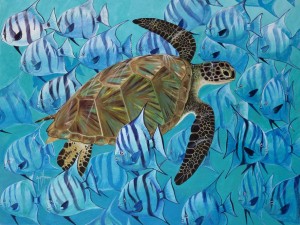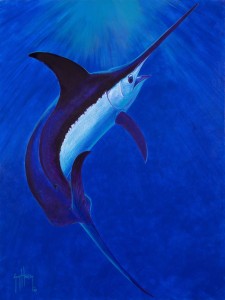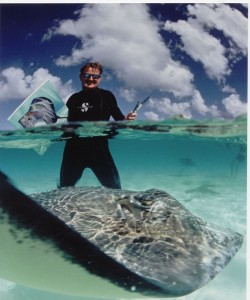Fishing and ocean sports culture has fused seamlessly with the work of Guy Harvey, and for good reason: the conservationist-turned-artist is unique in the way he captures undersea life and respectful in how he seeks to raise awareness for the depths. Born in Jamaica in 1955, Harvey was surrounded by fish and wildlife and became very interested in their existence, so much so that he earned a PhD in fisheries management from the University of the West Indies in 1982. Three years later, he drew scenes from Ernest Hemingway’s “The Old Man and the Sea” and fell in love with realistically depicting the creatures he studies and protects.
Harvey brings The Lure of the Ocean: Original Works by Guy Harvey to the Pensacola Museum of Art (PMA) May 9 through Aug. 9. The exhibition features some of Harvey’s best work in watercolors, mixed media and pen-and-ink drawings. The PMA is also creating additional interactive areas within the galleries for kids and adults to learn more about these beautiful creatures. Pensacola Magazine had the chance to chat with Harvey about his upcoming show, his passion for marine life, and his artistic methods.
A lot of people probably don’t realize you’re very much interested in marine conservation and research and even have a PhD. How did you become interested in that?
I learned my appreciation for our ocean resources from my parents, who were both very accomplished anglers. It was understood early in my life that responsible anglers should not take more fish than they can consume. I kept that lesson with me as I got older and went to a university to study fisheries management, and eventually did earn a Ph.D. with honors. Since that time we have learned even more about the threats facing our oceans and, thankfully, my business has succeeded to the point that I am able to use funds generated through the sale of my merchandise to benefit marine conservation through the Guy Harvey Ocean Foundation.

I have been drawing and painting for as long as I can remember. I’ve never had a lesson in my life, but when I was very young, I would draw the birds and other wildlife I would see on my family’s property in Jamaica. Of course, this includes the fish we would see when we were out on the water. When I was eight years old, I was sent to boarding school in England and would draw these animals when I would get homesick. I continued to paint into adulthood and eventually sketched a series of scenes from one of my favorite stories, Hemmingway’s “Old Man and the Sea”. This was one of my first public exhibitions and helped launch my career as a professional artist.
What do you hope to communicate with The Lure of the Ocean?
I always hope to give people a better appreciation of the wildlife that we have around us, especially the animals living below the sea surface that many people do not get to experience firsthand. Because these animals, and the ocean in general, can be so far removed from most people’s everyday life, it can be easy to forget and neglect. The Lure of the Ocean should give people a glimpse at the beauty of the undersea world and hopefully leave them with a better understanding that our oceans are a valuable resource that needs to be conserved.
What, to you, is the lure of the ocean?
To me, the ocean is always exciting. We have this massive marine ecosystem on our planet that covers 70 percent of the surface and makes up 99 percent of habitable space on Earth, yet we still know very little about it. So anytime you can venture offshore, it is an adventure and you will experience something new almost every time. And of course for me, it’s all about fishing and diving. I still get as excited today as I did the first time I saw a big fish hooked up. So much has to go right to catch one of these big, powerful fish that it is special anytime you can be near one. It’s the same with diving. To be underwater and experience this alien world first-hand is exciting every time.

That’s a tricky question because art and science almost go hand-in-hand for me. I have been drawing and painting for as long as I can remember but my first professional job was in the scientific field. The artwork obviously drives the business side of the equation but a reason my art is so popular, is because it is biologically accurate. I like to say that my hobby (painting) has become my profession and my profession (marine science) has become my hobby.
What methods do you employ when creating these pieces of art?
I paint in several different mediums, including acrylics and pen and ink, but my favorite is watercolor. I also do underwater photography and videography. But whatever I am doing, I try to keep the artwork authentic. More often than not, my paintings are of scenes that I have witnessed first-hand.
How do you feel about your name being synonymous with an entire culture of fishing and marine activity?
It is a big honor and I am very humbled that my name is so closely linked to the fishing and ocean-going lifestyles. People feel a very personal bond with the ocean world, from the coasts to the open ocean to undersea, so I am grateful that my artwork and I are part of that bond. But that is also something that I have worked hard for. Unlike some other fishing apparel brands, I think people appreciate that I am an actual person, out there living the lifestyle that my brand conveys. I am fishing and diving every chance I get and we have teams of researchers working to help conserve our ocean resources. It all comes down to authenticity.
Tell me about some of your recent conservation and research endeavors. 
Through the Guy Harvey Research Institute, we are involved in ongoing mako shark and oceanic whitetip tagging and tracking studies and are getting some fascinating results. The mako sharks have traveled further than anybody ever thought they did. We are also tagging and tracking blue and white marlin. All of these tracks are available online at www.GHRItracking.org. And through the Guy Harvey Ocean Foundation, we are funding other researchers working with bluefin tuna and lionfish. We also fund fishing and marine science camps to better engage kids in ocean conservation, since they are the future stewards of our oceans.